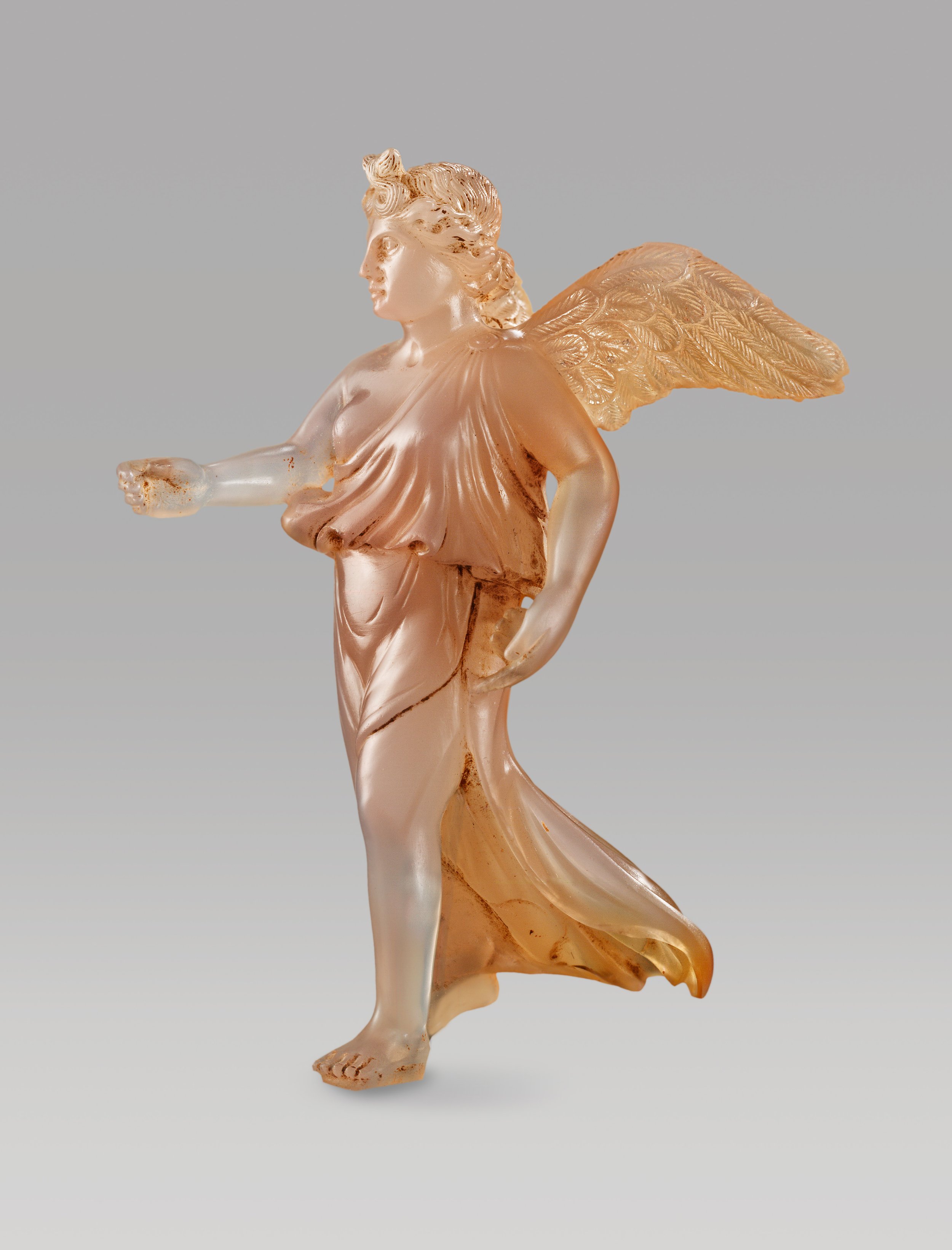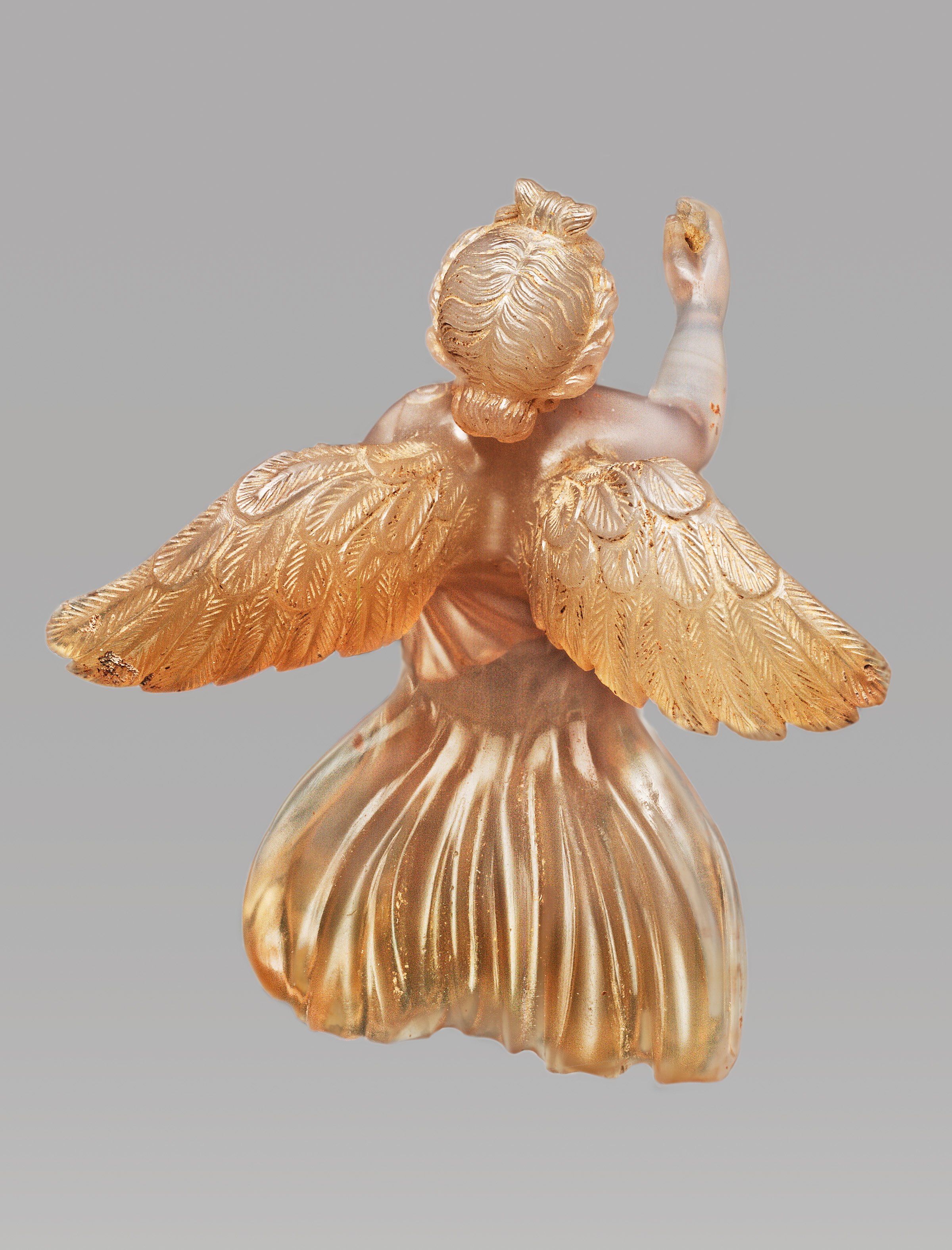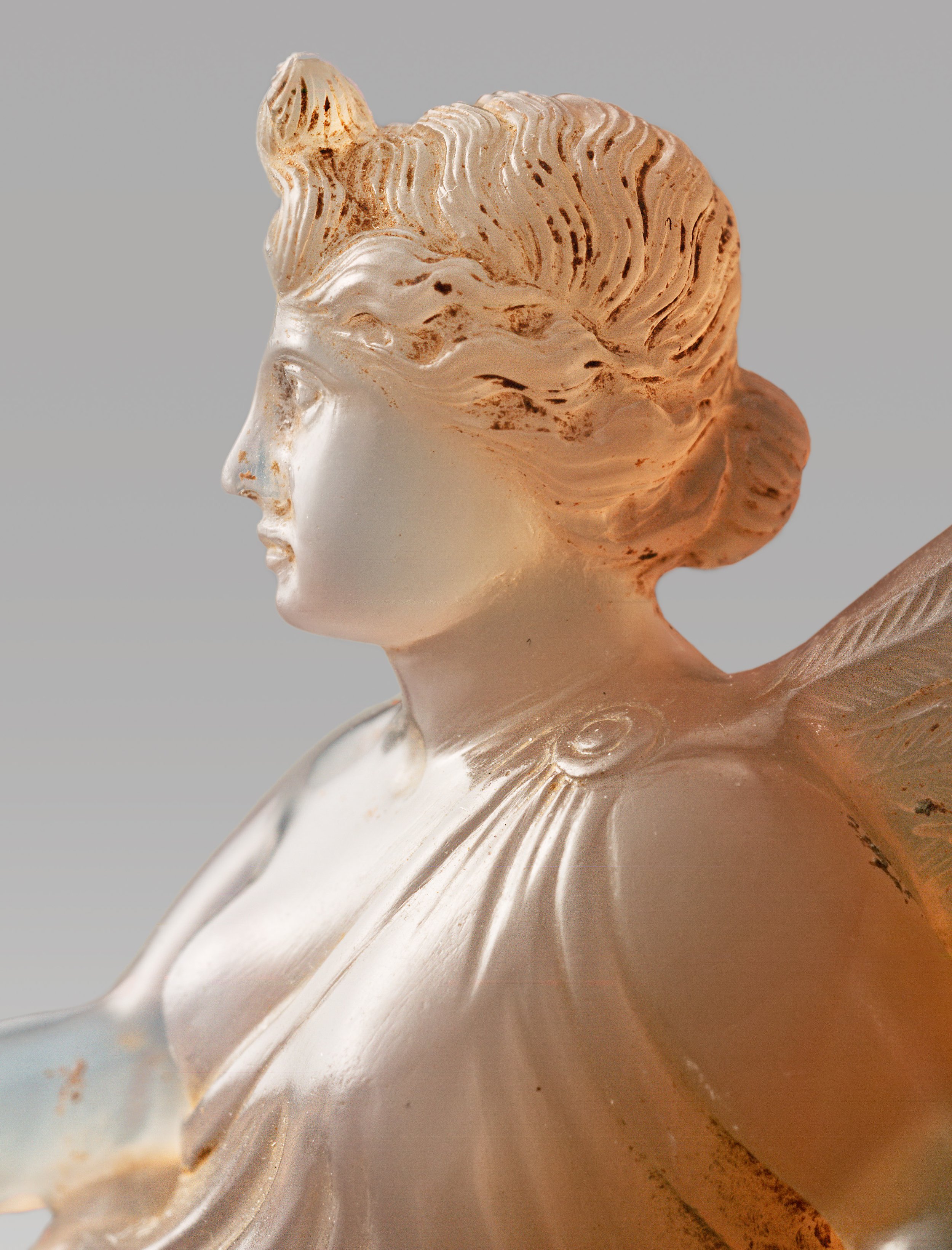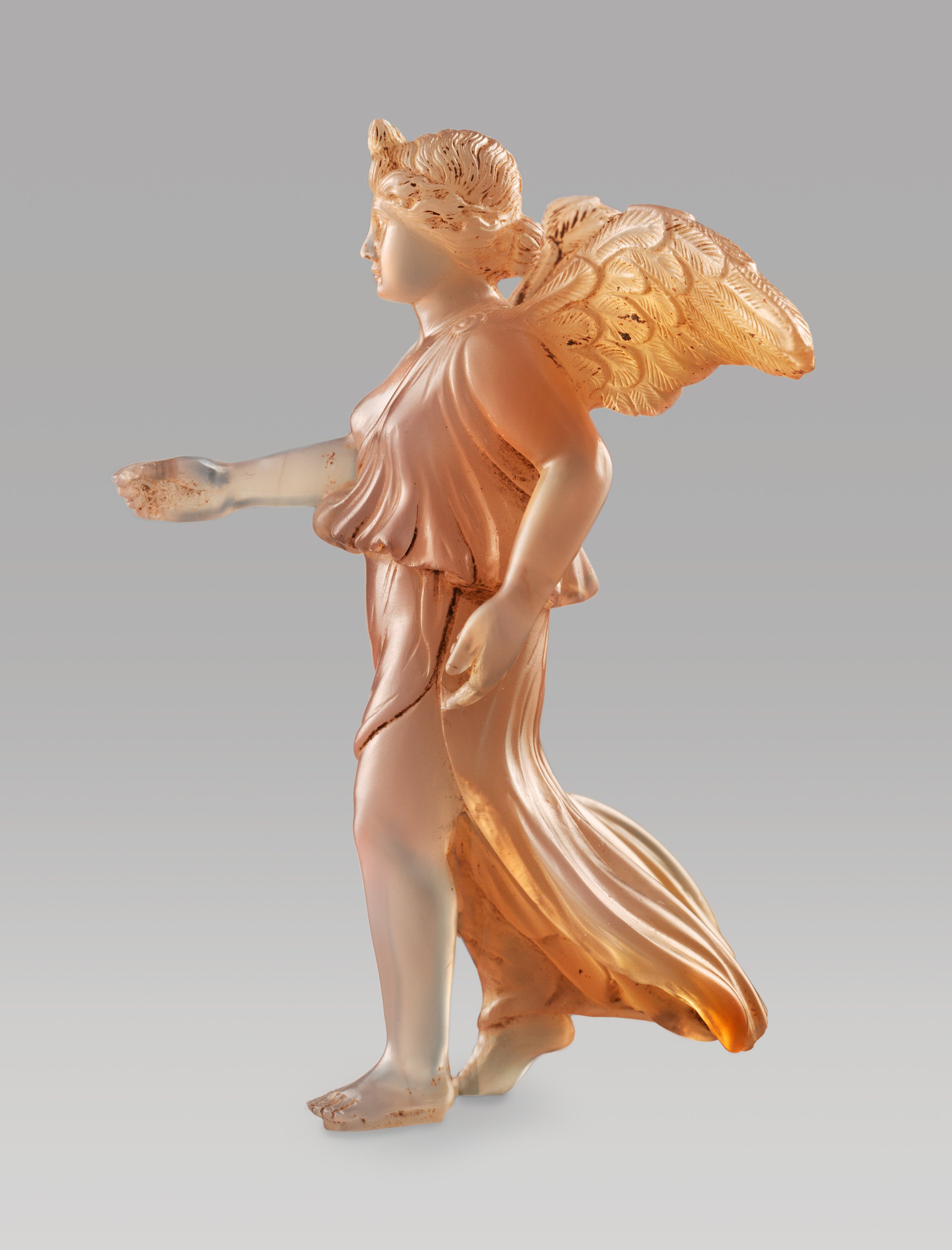Early Byzantine, ca. 5th century A.D. or earlier
Chalcedony
H: 8.8 cm
Statuette of Victoriola












Early Byzantine, ca. 5th century A.D. or earlier
Chalcedony
H: 8.8 cm
This outstanding statuette of Victory carved from a single block of chalcedony is a unique expression of sumptuary art in the early Byzantine period. Some would be surprised to see a representation of the goddess at a time when Imperial decrees prohibited devotion to ancient Roman gods. The many decrees and the vibrant denunciations issued by Christian writers (Prudentius, for instance) regarding public homage to the gods prove that ancient religion was not suddenly abandoned. As well as ancient religion, ancient culture was still very much alive in the early centuries of the Byzantine Empire and taught by both Christian and pagan writers.
The representation of the goddess of victory is therefore not unusual, but in keeping with a con-text still strongly influenced by Greco-Roman culture. It should not be understood as a religious representation, but as a symbol linked to the iconographic expression of Imperial power. From the times of Constantine, the Empire had resolutely turned to Christianity, causing a significant change in the conception of the Empire. To understand the place of such a representation of Victory in Roman iconography, one should briefly recall the founding of the Empire by Augustus.
Augustus made the goddess Victory the tutelary deity of the Empire. He placed his reign and that of his successors under the sign of military vic-tory. This idea was already widespread among the Sabines and the Romans of the Republic in the guise of deities who were synthesized in the figure of Victoria. This deity had been enriched by the Greek conception of Nike, the goddess of military victory, but also by the Games. This last conception, missing from the Italic conception, was quite popular in Rome, since a statue of the goddess was placed on a column of the Hippodrome. The function of the divinity remained marginal, however, at the expense of the important role she played in ensuring the power of the emperor. It is worth noting that the Games were for the Romans an expression of the power and generosity of the emperor with regard to his people.
On August 28, 29 B.C., to highlight this new ideological foundation and in honor of his victory at Actium, Augustus established the Altar of Vic-tory in the new Curia Iulia where the Senate was in session. This is the subject of an important discussion in the 4th century A.D. between Saint Ambrose of Milan and the representative of the senatorial aristocracy who remained faithful to paganism, Quintus Aurelius Symmachus (cf. De ara Victoriae). The latter fervently, but unsuccessfully, advocated the return of the statue removed in 382 on the order of Emperor Valentinian II.
The Altar of Victory was surmounted by a statue of the goddess taken by Augustus from the Greek temple in Taranto. The Tarentine Nike was made of gilded bronze; it was probably the work of an artist of the 4th century B.C. Augustus, in acting thus, transformed the Curia into a temple dedicated to Victory. In his conception, the Ro-man Empire received from the gods the mission to rule the world through his victories over the neighboring peoples; such was its destiny and its duty. To ensure its realization, the people and its leaders had to render public worship.
When the Empire turned to Christianity, this conception evolved. God gave the Empire dominion over the world, so that it would spread the “glad tidings” to the world. The Empire became the servant of God. During the 4th century A.D., a very interesting debate about the political conception of victory took place between Christian and pagan authors.
The statue in the Curia had an extraordinary impact. This representation of Victory, very margin-al before its establishment there, became wide-spread from that time onwards. It is thought to have been the model for most of the images of Victory depicted on coins, carved on memorial reliefs and triumphal arches and placed next to the Imperial portraits.
This statue did not survive the ages, although a gilded bronze foot recently discovered in Rome is thought to have been part of it. Its appearance is known from the description of authors such as Cassius Dio, Suetonius, Herodotus, Ambrose of Milan, Symmachus and Claudius Claudianus, as well as through depictions on intaglios and coins. The statue portrayed the goddess crowned with laurels, her tunic flying in the wind, her wings spread. The figure was represented touching down, one foot already resting on a globe, the other still in flight. She wore the insignia of vic-tory.
This description corresponds to our statuette, despite the absence of the globe. Carved from a single block of chalcedony, this masterpiece of Roman-Byzantine glyptic art combines the trans-lucent lightness of the stone and of the winged young woman with the strength and delicacy of the late Theodosian style. The tunic, flapping strongly in the wind, hugs her body, revealing her left leg and fluttering behind. Draped over a belt, the garment is fastened on her left shoulder by a round fibula, leaving her right shoulder and breast uncovered. The widely spread wings with the fi nely engraved feathers contrast with the smooth and light rendering of the skin and of the tunic. The right foot is still in flight, while the left foot is already placed on the object that supported the figure. A tiny pedestal fitting just under the left foot indicates that the statuette would have been inserted into another object (a globe, a plaque, the hand of a statue?). The right arm reaches forward and would have held an object now lost (a palm, a crown?). The left arm, slightly bent, falls along the body and, given the disproportion of the hand, would have carried a seemingly longer object (a palm, an insignia, a shield?). A laurel crown placed in the hair would have completed the statuette. These elements, now missing, would have been made of a precious material such as gold, ivory or silver.
The head, a masterpiece of quiet confidence, of determination, of perseverance and of contained joy, plays again on the contrasts of the stone. The smooth face has a straight nose, a small closed mouth and heavy oval eyes that are clearly re-lated to the style of ivories from the 5th-6th century A.D. The hairstyle, gracefully detailed by the engraving of each lock, comprises a knot of hair arranged above the forehead, voluminous locks framing the face and a low bun falling on the nape, certainly so as to place a crown on the head.
These small statuettes of Victory are document-ed from the 1st century B.C. on a skyphos (two-handled wine cup) from the “Boscoreale treasure”, showing Augustus receiving a Victoriola from a deity. Their purpose and use may vary. It is attested that such statuettes accompanied the ancient emperors during military campaigns. They were also offered as gifts to them and are thought to have played a role in the celebration of triumph and Imperial pomp that may have taken place in a palace or a circus.
From the 2nd century A.D., a Victoriola mounted on a globe became an Imperial attribute, as evidenced by coins, as well as by descriptions of Imperial statues. This iconography has been variably successful over the centuries, depending on the ideology promoted by the various reigns. The presence of the statuette as an attribute gradually divested of its divine nature is still attested under the emperors who became Christians.
Indirect testimonials report this late use. A famous motif from the Chronography of 354, now in the Vatican, depicts a monument showing the full-length figure of Constantine the Great hold-ing a Victoriola in his outstretched hand. A later illustration of this use appears in a drawing from the Freshfi eld Album in Trinity College, Cam-bridge. It represents the base of the Column of Arcadius, located in the Forum of Arcadius, in Constantinople (the column was destroyed in 1715 by the Ottomans). The eastern and western emperors, Arcadius (395-408 A.D.) and Honorius (395-423 A.D.), face each other in the second register of the south wall, each holding a small Victoriola in his right hand.
The closest parallels for this Byzantine chalcedony statuette are ivories from the 5th-6th century. Winged Victories illustrate civil works, such as the consular diptych of Probus (406) in the Cathedral of Aosta, representing the emperor Honorius standing clad in armor and carrying in his hand a Victoriola on a globe. On the diptych (5th century) in the Riccardi Collection, in Florence, one may admire the personification of Rome holding a Victoriola on a globe. On the example (middle of the 5th century) formerly preserved in the Cathedral of Hamburg is Victory triumphing over a Barbarian. On the example (ca. 500) housed in Castello Sforzesco, in Milan, are two Victories carrying the bust of Constantine in a laurel wreath. The consular diptych of Basilius (480) in Castello Sforzesco, in Milan, shows Victory seated and holding the consul’s portrait. Finally, on the famous Barberini ivory (6th century), Jus-tinian on horseback is crowned by Victory and accompanied by a general who gives him a Vic-toriola; the representation of Justinian on horse-back could be a copy of an equestrian statue of the emperor crowned by Victory, which was erected in Constantinople. Other official statues of emperors adorned the capital city. One can therefore imagine many reproductions of the ancient goddess on Byzantine civil monuments. It is known, besides, that the personification of Rome, placed by Constantine in a small building facing that of the personifi cation of Constantinople at the founding of the new capital, would have also held a small Victoriola.
There were thus many representations of Victory in the first centuries of the Byzantine Empire. They were part of the iconographic repertoire of power, an Imperial personification and attribute. Our beautiful chalcedony statuette belonged to this context and would have been part of a statue, or erected on a globe or on a plaque celebrating a victory and meant to be offered as a gift.
Rare are the examples of precious stone figurines from the 4th-5th century. The most significant examples are housed in the Walters Art Museum, in Baltimore: a small crystal statuette of Hercules and the Erymanthian Boar (inv. 42.208, 4th century, although F. Brommer relates it to a crystal statuette of Hercules found at the Acropolis, in Athens, and dated to the 1st century) and a lapis lazuli eagle (inv. 42.1406, 4th-5th century) probably placed on a scepter.
The use of chalcedony in glyptic art is attested for earlier works, including portraits of children and of emperors. Full-length female statuettes are much rarer. The famous chalcedony Victory (1st-2nd century) in the Metropolitan Museum of Art, in New York, thus gives a thematic echo to our Victory; it offers an important stylistic point of comparison, which allows us to confi rm a much later date for the Byzantine Victory. One should also mention the chalcedony figurine (1st century B.C.) found in a tomb near Cologne-Weiden, now in the Staatliche Museen, in Berlin, depicting a draped woman identified as Persephone. The small Venus (4th-5th century) housed in the Walters Art Museum, in Baltimore, could be contemporary with our statuette, though of lower quality. Finally, in the Kunsthistorisches Museum, in Vienna, one may consider the beautiful statuette of a seated divinity (Concordia?) (inv. ANSA.X.15, 3rd century) and the head of a statuette of Isis (inv. ANSA.X.26, middle of the 1st century).
These five statuettes are remarkable examples of chalcedony works, a stone difficult to carve (7 on the Mohs scale of mineral hardness). The size of the blocks used for these objects was a challenge that only great masters of glyptic art would take up. The translucent and milky brightness of chalcedony seems to particularly suit the theme of victory. The master of the Byzantine Victoriola perfectly exploited the huge stone that he had been given. This statuette can be considered as a great masterpiece of the period.
PROVENANCE
Ex- Habermacher Gallery, Schweizerhofquai, Lucerne, prior to 1982;
Ex- Swiss private collection, acquired from the above, in 1982;
Ex- Art Market, Geneva, 2011;
Qatar Investment, 2014
BIBLIOGRAPHY
On the carving of precious stones in ancient times, see: TALLON F., Les pierres précieuses de l’Orient ancien: Des Suméri-ens aux Sassanides, Paris, 1995.
On examples of fi gures of Victory in the 4th-5th century A.D., see: Romans and Barbarians: Museum of Fine Arts, Boston, Boston, 1976, p. 114, No. 122.
VOLBACH W.F., Elfenbeinarbeiten der Spätantike und des frühen Mittelalters, Mainz/Rhine, 1952, pl. 10, No. 38; pl. 12, Nos. 48-49; pl. 15, No. 5.
On the fi gure of Victory in the iconography of Roman power, see: BERLINGER A.R. and BERLINCOURT M.A., Victory as a Coin Type, in Numismatic Notes and Monographs, 149, New York, 1962.
HOELSCHER T., Victoria Romana, Mainz/Rhine, 1967.
POHLSANDER H.A., Victory: The Story of a Statue, in Historia, 18, 1969, pp. 588-597.
On statuettes in glyptic art, see:
BROMMER F., Antiken des Athener Instituts, in Mitteilungen des Deutschen Archäologischen Instituts: Athenische Abteilung, Vol. 87, 1972, pp. 289-291, pl. 100.
Early Christian and Byzantine Art: Walters Art Gallery, Baltimore, Baltimore, 1947, p. 110-114, pl. LXXIV-LXXV, Nos. 534 and 545.
Über die Sammlungen von Altertümern des Schloss Friedenstein zu Gotha, in Jahrbücher des Vereins von Altertumsfreuden im Rheinlande, XLI, Bonn, 1866, p. 52-55.
Übersicht der Kunsthistorischen Sammlungen des Allerhöchsten Kaiserhauses, Vienna, 1920.
ZWIERLEIN-DIEHL E., Antike Gemmen und ihr Nachleben, Berlin, 2007, p. 443, pl. 147, No. 654.
ZWIERLEIN-DIEHL E., Constantinople et Rome: Intailles du IVe et du Ve siècle après Jésus-Christ, in La glyptique des mondes classiques: Mélanges en hommage à Marie-Louise Vollenweider, Paris, 1997, p. 83-96.
ZWIERLEIN-DIEHL E., Die Chalcedonstatuette aus der Römischen Grabkammer in Köln-Weiden, in Jahrbuch der Berliner Museen, Vol. 27, 1985.
On the theology of victory in the 4th century A.D., see:
HEIM F., La théologie de la victoire de Constantin à Théodose, Paris, 1992.
MUSTI D., Simbologia della vittoria dall’ellenismo a Costantino, in Nike: Ideologia, iconografi a e feste della vittoria in età antiqua, Rome, 2005, pp. 25-43.
SODINI J.-P., Images sculptées et propagande impériale du IVe au VIe siècle: Recherches récentes sur les colonnes honorifi ques et les reliefs politiques à Byzance, in Byzance et les images, Paris, 1994, pp. 41-94.
Notes
J. Odgen, Ancient Jewelry (Berkeley, 1992), 19-20, for ancient carving techniques.
J. Padgett, “A Chalcedony Statuette of Herakles,” in Record of the Art Museum 54:1 (Princeton, 1995), 3-22.
Pliny, Natural History 37.11-118, for commentary on gemstones and stone statuettes.
C. Vermeule, Greek and Roman Sculpture in Gold and Silver (Boston, 1974), for statuettes in gold and silver.
For the Nike by Paionios: Lexicon Iconographicum Mythologiae Classicae (LIMC), vol. 6, 862-63, pl. 572, Nike 137.
For the Nike in the agora of Cyrene, and the Nike from Samothrace:
LIMC, vol. 6, 881-82, pls. 588-89, Nike 381, Nike 382.
For comparable terracotta statuettes of Nike from Myrina: LIMC, vol. 6, 887, pl. 595, Nike 492, 495, 496, 494, all of Type 1, represented with the right breast undraped and with the left leg placed forward, undraped to the thigh. See also D. Burr, Terra-cottas from Myrina in the Museum of Fine Arts, Boston, Ph.D. diss., Bryn Mawr College, 1934, 57-63, pls. 26-30; S. Mollard-Besques, Catalogue raisonné des figurines et reliefs en terre cuite grecs, étrusques et romains, Louvre, vol. 2: Myrina (Paris, 1963), 65-74, pls. 80-91.
For the chalcedony statuette of Nike at the Metropolitan Museum of Art, NY (MMA 06.1161) see: C. Picón, et al., Art of the Classical World in the Metropolitan Museum of Art (New York, 2007), 362, 487, no. 419; J. Padgett, “A Chalcedony Statuette of Herakles,” in Record of the Art Museum 54:1 (Princeton, 1995), 9, fig. 9; G. Richter, Catalogue of Engraved Gems: Greek, Etruscan, and Roman, 2nd ed. (Rome, 2006), 125, no. 621, pl. 69; G. Richter, Handbook of the Classical Collection (New York, 1930), 334, fig. 239; E. Robinson, “New Greek and Roman Acquisitions: III. Gems and Objects in Precious Metals,” Bulletin of the Metropolitan Museum of Art 2:7 (1907), 124, fig. 4.
For a small bronze column surmounted by a statuette of Nike in the Museum of Fine Arts, Boston (MFA 1976.150): C. Vermeule and M. Comstock, Sculpture in Stone and Bronze in the Museum of Fine Arts, Boston (Boston, 1988), 68-69, no. 70.
In addition to gemstone statuettes of gods and mortals, there also exist fully modeled sculptures of eagles, lions, dolphins, and other creatures. At least half of the surviving statuettes represent gods or mythological figures, and some women of this group should be identified as goddesses. Following are the statuettes of chalcedony or semi-precious stone listed in Padgett (1995): 1) Empress, translucent purple stone ("amethyst"), h. 8.9 cm., London, Victoria and Albert Museum 281.1874; 2) Draped woman, plasma, h. 7 cm., Gotha, Schlossmuseum; 3) Draped woman, rock crystal, h. 8.0 cm., Washington, D.C., Freer Gallery of Art F09.61; 4) Draped woman, chalcedony, h. 10.2 cm., Berlin, Antikensammlung, Staatliche Museen Preussischer Kulturbesitz S.5047; 5) Torso of draped woman, chalcedony, h. 8.8 cm., Hamburg, Museum für Kunst und Gewerbe 1917.1007; 6) Torso of a man wearing a toga, brownish yellow jasper, h. 18.7 cm., New York, Metropolitan Museum of Art 17.230.54; 7) Legs of a man wearing a toga, "onyx," h. 9.0 cm., London, British Museum 3956; 8) Torso of man wearing a cuirass, rock crystal, h. 9.5 cm., Paris, Musée du Louvre Bj 2109; 9) Draped man, in two pieces, rock crystal, h. 7.0 cm. and 4.5 cm., London, British Museum 3957; 10) Seated male infant, chalcedony, h. 2.7 cm., Vienna, Kunsthistorisches Museum X 21; 11) Reclining male infant, chalcedony, l. 4.0 cm., Vienna, Kunsthistorisches Museum X 20; 12) Enthroned goddess, chalcedony, h. without alien head: 6.0 cm., Vienna, Kunsthistorisches Museum X 15; 13) Seated man wearing a cuirass and himation, plasma, h. 10.5 cm., private collection; 14) Euthenia, chalcedony, l. 19.5 cm., Paris, Musée du Louvre Bj 2113; 15) Asklepios, purple fluorite, h. 5.7 cm., Taunton, Content Family Collection; 16) Nike, chalcedony, h. 7.3 cm., New York, Metropolitan Museum of Art 06.1161; 17) Abduction of Ganymede, chalcedony, h. 4.8 cm., New York, private collection; 18) Aphrodite, plasma, h. 5.8 cm., Vienna, Kunsthistorishes Museum X 17; 19) Aphrodite, chalcedony, h. 15.0 cm., Paris, Musée du Louvre Bj 2114; 20) Aphrodite Anadyomene, chalcedony, h. 3.6 cm., Baltimore, Walters Art Museum 42.161; 21) Aphrodite Anadyomene, chalcedony, h. with base 13 cm., Paris, Rothschild collection; 22) Crouching Aphrodite, rock crystal, h. 8.5 cm., Malibu, J.Paul Getty Museum 78.AA.248; 23) Herakles, walking, chalcedony, h. 3.5 cm., The Art Museum, Princeton University y1992-50; 24) Herakles, standing, chalcedony, h. 6.3 cm., Vienna, Kunsthistorisches Museum X 24; 25) Herakles battling the Nemean Lion, rock crystal, h. 4.5 cm., Athens, Deutsches Archäologisches Institut; 26) Herakles carrying the Erymanthian Boar, rock crystal, h. 7.5 cm., Baltimore, Walters Art Museum 42.208.
